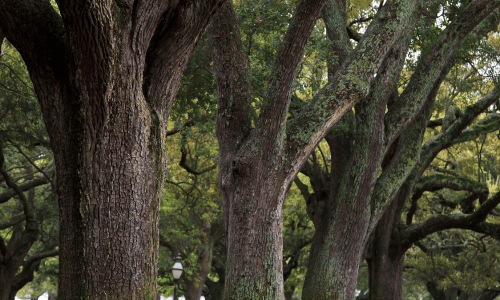Oak wilt is a devastating fungal disease that affects oak trees, leading to rapid decline and death. As a property owner in Dallas, Texas, understanding how to treat and prevent oak wilt is essential to maintain the health and beauty of your oak trees. In this comprehensive guide, we’ll discuss six simple steps for treating oak wilt, delve into the importance of working with a professional tree service in Dallas, like Texas Tree Transformations for Tree Disease & Fungus Management, and provide valuable tips for oak tree care and maintenance.
1. Identify Oak Wilt Symptoms
The first step in treating oak wilt is to identify the symptoms of the disease. Common signs include:
Rapid leaf discoloration:
Leaves may turn yellow, brown, or even red, depending on the tree species. This change in color usually starts at the leaf tips and progresses toward the leaf base.
Wilting:
Leaves may appear wilted, even when the tree has access to sufficient water.
Defoliation:
Infected trees may lose their leaves quickly, often within a few weeks.
Distinct pattern of discoloration:
Affected leaves often have a unique pattern of discoloration, with the veins turning a dark color while the rest of the leaf remains green.
If you suspect that your oak tree is suffering from oak wilt, it’s crucial to consult with a professional tree service like Texas Tree Transformations to assess the situation and recommend appropriate treatment options.
2. Prevent the Spread of Oak Wilt
Preventing the spread of oak wilt is essential to protect other oak trees in your area. The fungus that causes oak wilt can spread through root grafts between neighboring trees or via insects like beetles that are attracted to the fungal spores. To minimize the spread of the disease, consider the following tips:
- Avoid pruning or wounding oak trees during the active growing season when the fungus is most likely to spread. Instead, schedule pruning during the dormant season, usually in late fall or winter.
- If you must prune during the growing season, use a tree wound dressing to seal the cuts and deter beetles. However, be cautious when using wound dressings, as they can sometimes do more harm than good if not applied correctly.
- Maintain a healthy landscape by providing proper tree care, including regular watering, mulching, and fertilization. Healthy trees are better equipped to resist disease and insect infestations.
3. Remove Infected Trees
In some cases, the best course of action may be to remove infected trees to prevent the spread of oak wilt to nearby healthy trees. This step should be done with care and under the guidance of a professional tree service like Texas Tree Transformations to minimize damage to other trees and ensure safe removal. Proper disposal of the infected tree material is also crucial to prevent the spread of the disease. Consider the following:
- Chipping or burning infected tree material to destroy the fungus.
- Covering the wood with a tarp or clear plastic to trap and kill any beetles that may emerge from the wood.
- Storing the wood away from healthy oak trees to reduce the risk of spreading the disease.
4. Implement Root Barrier Treatments
Root barrier treatments can help slow the spread of oak wilt between trees through root grafts. This process involves:
- Severing the roots of affected trees to break root connections between infected and healthy trees.
- Installing a physical barrier, such as a plastic sheet, between the infected and healthy trees to prevent new root grafts from forming.
- Treating the soil with a chemical fumigant to kill the fungus in the area around the infected tree.
- A professional tree service, such as Texas Tree Transformations, can help you determine the best approach for implementing root barrier treatments on your property.
5. Apply Fungicide Treatments
Fungicide treatments can be an effective method for controlling oak wilt in certain situations. The most commonly used fungicide for oak wilt treatment is propiconazole, which can be injected directly into the tree trunk. This treatment may help slow the progression of the disease and prolong the life of the tree. However, it’s important to note that this method is not a guarantee and may not be effective in all cases. Consult with a professional tree service like Texas Tree Transformations to determine if fungicide treatments are appropriate for your specific situation.
6. Monitor and Maintain Oak Trees
Regular monitoring and maintenance of your oak trees are essential for preventing and managing oak wilt. Keep an eye out for any signs of the disease, and take action promptly if you notice symptoms. In addition to monitoring, proper tree care practices can help keep your oak trees healthy and resistant to diseases like oak wilt. Some tips for maintaining healthy oak trees include:
- Watering your trees during dry periods, ensuring they receive adequate moisture without overwatering.
- Mulching the base of the tree to help conserve soil moisture, moderate soil temperature, and reduce weed growth.
- Fertilizing your trees as needed, based on soil tests and recommendations from a professional arborist.
- Pruning dead or damaged branches to maintain tree health and structure.
Conclusion
Oak wilt is a serious threat to oak trees in Dallas, Texas, and understanding how to treat and prevent this disease is crucial for preserving the health and beauty of your trees. By following these six simple steps and working with a professional tree service like Texas Tree Transformations, you can help protect your oak trees from oak wilt and ensure they thrive for years to come. Reach out to Texas Tree Transformations today for expert advice and assistance with all your tree care needs.
More Resources:
Who is Responsible for Tree Trimming in Dallas, Texas?

